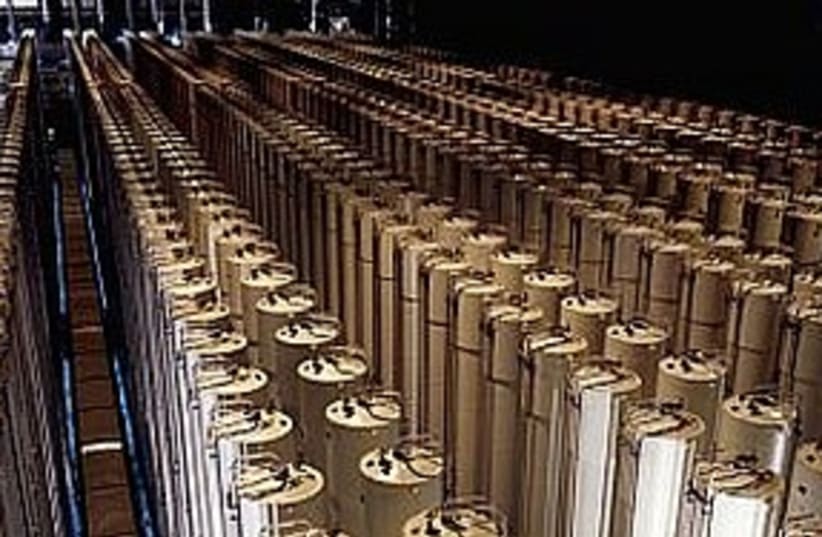RELATED:Panetta: Iran has uranium for 2 bombs'Iran amassing enriched uranium'Iran agrees to ship most of its enriched uranium to TurkeyThe ISIS reported in July that Iran had announced it was planning on recycling the tails while producing 19.75% uranium. The efficient process is described by the ISIS: "The two percent enriched tails from the first cascade is fed into the feed point of the second cascade and emerges as about 10 percent enriched uranium. This material is then fed into an upper stage of the first cascade, while the 3.5 percent uranium is fed in at the main feed point of this cascade. With two feed points, the total amount of 19.75 percent product is not increased, but the enrichment effort embodied in the 2 percent material is more fully utilized. The assay of the tails in the second cascade is 0.7 percent enriched uranium, or natural uranium. This material can then be reused in cascades at the main Fuel Enrichment Plant (FEP) at Natanz that make 3.5 percent uranium."According to the ISIS, the "second cascade" recycling process enables Teheran to minimize "wasting separative work units (swu) in the enrichment process and ultimately requires less 3.5 percent LEU to produce a given quantity of 19.75 percent material." The ISIS reported that Iran is not limited in its amount of 3.5 percent material to produce "research reactor fuel and will not be anytime soon." As a result, there is no need for Iran "to worry about using its tails efficiently," explained the organization.However, the ISIS stated that Teheran is "expected to use the same type of procedure to reduce the amount of separative work left in the tails" if it will decide to enrich uranium to the level of weapon-grade. The process "stepwise increases the enrichment level of the uranium, reducing the amount of feed material it needs at each step." The think-tank explained that "Iran likely received the same plans that the Khan network gave Libya detailing how to organize and run cascades to produce weapon-grade uranium from natural uranium in four steps, including recycling the tails produced in the top three steps (the first step goes from natural uranium to 3.5 percent LEU and produces about 0.4 percent tails)."The report adds that Teheran's current moves of uranium enrichment "while superficially justified on civil grounds, mainly make sense in the context of learning how to make significant quantities of highly enriched uranium efficiently."
Report: Iran enrichment more efficient
US based ISIS explains Teheran's improvement in uranium enrichment.

RELATED:Panetta: Iran has uranium for 2 bombs'Iran amassing enriched uranium'Iran agrees to ship most of its enriched uranium to TurkeyThe ISIS reported in July that Iran had announced it was planning on recycling the tails while producing 19.75% uranium. The efficient process is described by the ISIS: "The two percent enriched tails from the first cascade is fed into the feed point of the second cascade and emerges as about 10 percent enriched uranium. This material is then fed into an upper stage of the first cascade, while the 3.5 percent uranium is fed in at the main feed point of this cascade. With two feed points, the total amount of 19.75 percent product is not increased, but the enrichment effort embodied in the 2 percent material is more fully utilized. The assay of the tails in the second cascade is 0.7 percent enriched uranium, or natural uranium. This material can then be reused in cascades at the main Fuel Enrichment Plant (FEP) at Natanz that make 3.5 percent uranium."According to the ISIS, the "second cascade" recycling process enables Teheran to minimize "wasting separative work units (swu) in the enrichment process and ultimately requires less 3.5 percent LEU to produce a given quantity of 19.75 percent material." The ISIS reported that Iran is not limited in its amount of 3.5 percent material to produce "research reactor fuel and will not be anytime soon." As a result, there is no need for Iran "to worry about using its tails efficiently," explained the organization.However, the ISIS stated that Teheran is "expected to use the same type of procedure to reduce the amount of separative work left in the tails" if it will decide to enrich uranium to the level of weapon-grade. The process "stepwise increases the enrichment level of the uranium, reducing the amount of feed material it needs at each step." The think-tank explained that "Iran likely received the same plans that the Khan network gave Libya detailing how to organize and run cascades to produce weapon-grade uranium from natural uranium in four steps, including recycling the tails produced in the top three steps (the first step goes from natural uranium to 3.5 percent LEU and produces about 0.4 percent tails)."The report adds that Teheran's current moves of uranium enrichment "while superficially justified on civil grounds, mainly make sense in the context of learning how to make significant quantities of highly enriched uranium efficiently."